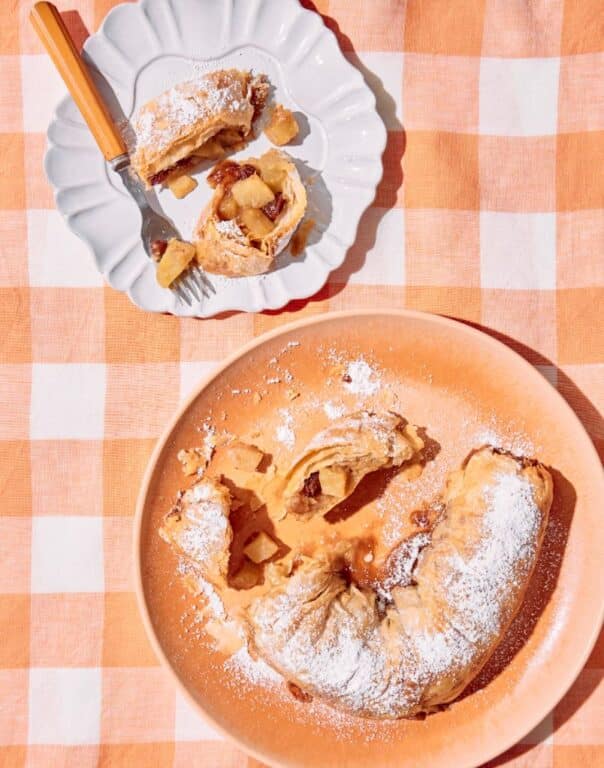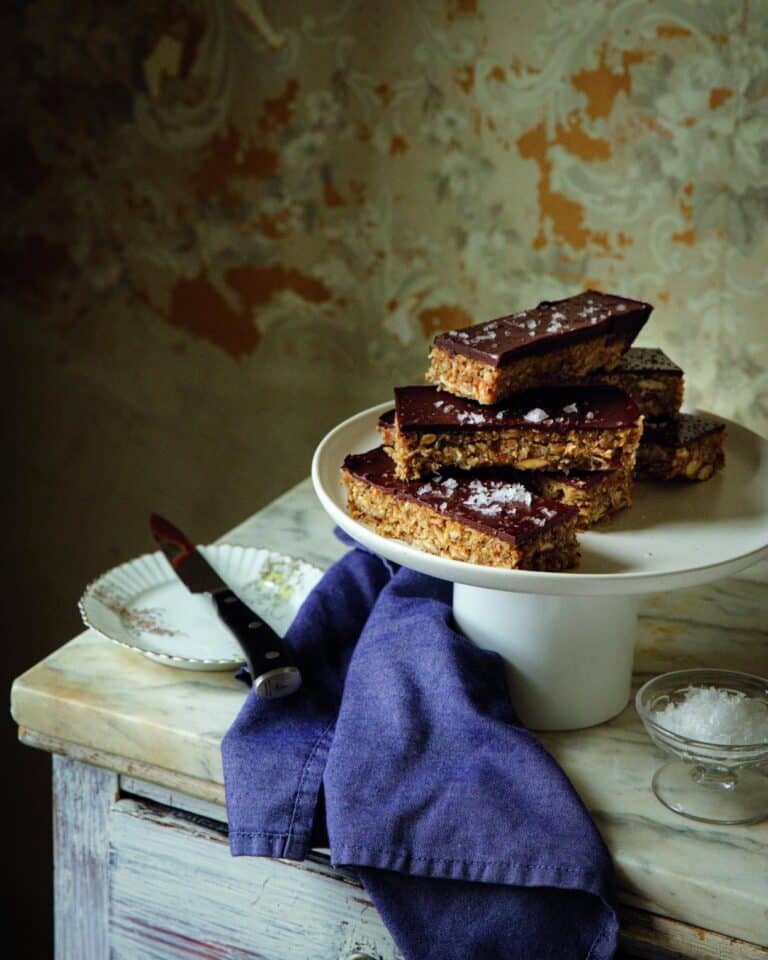
It’d be pretty rudel to not make a strudel. Ideally, use a few different varieties of apples in the filling so they can fight it out to offer the most flavour, but the strudel will still be delectable even if you just use good old granny smith apples. – Zacchary Bird
Easy | Serves 8–10
Pastry Ingredients
- 1 × quantity Filo pastry (below) or up to 375 g (13 oz) store-bought vegan filo
- 120 g (4 ½ oz) vegan butter, melted
- 65 g (2¼ oz) brown sugar icing (confectioners’) sugar, for dusting vegan vanilla ice cream, to serve
Spiced Apple Filling Ingredients
- 100 g (3½ oz) raisins
- 60 ml (2 fl oz) rum or brandy
- 850 g (1 lb 14 oz) baking apples
- zest and juice of 1 lemon
- 100 g (3½ oz) brown sugar
- 1 teaspoon ground cinnamon
- ½ teaspoon sea salt
- ¼ teaspoon ground nutmeg
- pinch of ground cloves (optional)
- 25 g (1 oz) almond meal (or extra breadcrumbs)
- 25 g (1 oz) dried breadcrumbs
Directions
- Start by soaking the raisins for the filling. Add the raisins to a jar. Gently heat the rum in a small saucepan (or in a microwave-safe bowl) until warm but not hot, to preserve the booze content. Pour the rum over the raisins, seal the jar and set aside for a few hours – or up to a week – to soak. (If leaving for an extended time, shake the jar every day or so.) For those avoiding alcohol or effort, splash about 2 tablespoons of boiling water over the raisins for 5 minutes and drain before using instead.
- Peel and core the apples, then cut into 1 cm (½ in) cubes and toss in a large bowl with the lemon zest and juice and brown sugar. Toss it all together to stop the apple browning, then toss through the cinnamon, salt, nutmeg and cloves, if using. Leave to sit for a few minutes, then stir the raisins, almond meal and breadcrumbs through to drink up the excess liquid.
- Preheat the oven to 180°C (350°F). Line a large baking tray with baking paper or a silicone baking mat. When working with the filo pastry, either proceed quickly or cover with a scarcely damp tea towel to stop it drying out.
- Lay a sheet of filo on the benchtop. Using a pastry brush, splatter a little melted butter over the top, in your best Jackson Pollock impersonation, being careful to avoid over-saturating it. Similarly scatter about a teaspoon of brown sugar over. Add another filo sheet and repeat with more butter and sugar. Continue until four pastry sheets have been stacked on top of each other. (Note, you will need fewer sheets if using homemade filo pastry.)
- Evenly spoon half the filling along the long edge of the pastry, smoothing the filling flat. Fold the pastry over to encase the filling, compressing slightly to pack it in. Taking care not to rip the pastry, continue to roll until a cylinder is formed. Adjust so that the filling is distributed evenly along, then tuck each end under to secure. Repeat with the remaining pastry and filling to make a second strudel.
- Curve the strudels into a horseshoe shape (for a better fit) and place on the baking tray. (You can always use a second baking tray if needed!) Make sure the seam and tucked ends are under the pastry, then brush all over with more butter.
- Bake for 40–45 minutes, until the pastry is golden all over. Remove from the oven and leave to cool for 20 minutes before dusting icing sugar all over the top. Slice and serve warm with ice cream.
- The strudel will keep in an airtight container in the fridge for up to 5 days. Reheat in the oven or an air fryer to crisp up the pastry, as it will become soggy.
FILO PASTRY
MEDIUM | Makes 650 G (1 LB 7 OZ)
I adore the meditative practice of stretching out fresh filo on a giant table the traditional way, by hand, before industrial versions became commonplace. The tactile process of physically dragging the protein strands just about to their limit gives one enormous insight into the unique stretchability of gluten. You’d know it was thin enough when you could read a newspaper through the pastry sheet. Sadly, newspapers are harder to find by the day – but, gladly, store-bought filo that’s vegan is commonplace, and reliably rolled thinner than many of us could.
For uber-thin layers and convenience, there’s no shame in using store-bought versions; you’ll find the best-quality filo in the chilled aisle, rather than the freezer section. After all, filo pastry takes patience, and thinly rolling it by hand is time consuming, as the gluten needs time to relax and stretch out without tearing. The reward for the wait? Beautifully rustic results, more control over pastry shaping, as well as fewer sheets drying out and ripping along the way. Basically, don’t be hasty when rolling out this pastry … you filo me?
Ingredients
- 400 g (14 oz) bread flour
- 1 1/2 teaspoons fine salt
- 4 teaspoons white vinegar
- 2 tablespoons olive oil,
- plus 100 ml (3½ fl oz) extra, for brushing
- 30 g (1 oz) cornflour (cornstarch)
Directions
- In the bowl of a stand mixer fitted with the dough hook, combine the flour, salt, vinegar and 200 ml (7 fl oz) of water on low speed until a loose dough forms. Increase the speed to medium for 5 minutes. Slowly pour in the 2 tablespoons of olive oil over the course of 2 minutes, then knead for a total of 10 minutes, until you have a smooth ball that pulls away from the side of the bowl.
- The dough may be slightly sticky, so rub a small amount of olive oil over the surface with your hands, then form into a ball and wrap tightly with plastic wrap. Rest in the fridge for at least 4 hours (and up to 24 hours) to fully relax.
- Prepare a large work surface to roll the dough out on. A flat, cleared table with all sides free is ideal, but home cooking is all about making do, so designate your largest free area for this task.
- Divide the dough into 320 g (11½ oz) halves with a dough scraper.
- Cover one with plastic wrap and return it to the fridge. Take a second to familiarise yourself with the dimensions of your benchtop.
- Using a pastry brush, coat the dough in oil, then use a rolling pin to begin pressing out the dough to lengthen it.
- Flip the dough over and start rolling it out into a rectangle. Keep flipping the dough and re-oiling both sides as you go to prevent sticking.
- Finally, switch to hand-pulling the filo sheet by lightly pinching a section of the rolled dough, picking it up off the bench and ‘walking it out’ to a space on the bench further out. The dough should be sticky enough to stay in place as you move it out, and will start to become translucent. Continue around the dough until it is thin enough to see the pattern of the bench beneath you that you mentally noted earlier, and measures about 60 cm × 80 cm (24 in × 32 in).
- Press together any small tears and forgive yourself for any large ones, as they’ll likely be wrapped up in pastry layers and undetectable later on. Let it sit for 10 minutes so that the gluten doesn’t try to retract the sheet back.
- Wipe the pastry brush clean and lightly sprinkle half the cornflour over the filo. Dust off excess flour while brushing the cornflour evenly over the top. Use a pizza slicer to shape into sheets; I aim for about 30 cm × 40 cm (12 in × 16 in) each. Repeat with the remaining dough.
- Use immediately to layer with fat for pastries, or store until needed as follows: lay a sheet of baking paper over each filo sheet, then gently roll it up from one end. These filo cylinders protect the layers from sticking together, and are efficient space savers in storage.
For best results, use the pastry immediately (after all, you’ve gone to the effort to make it fresh!). However, if you need to keep leftovers, wrap in plastic wrap to seal the roll, then store in the fridge for up to 2 days. Alternatively, freeze in the cylinder for up to 2 months, and gently thaw in the fridge or on the bench before use.
-
 The Vegan Baker$35.00
The Vegan Baker$35.00
Recipes from The Vegan Baker by Zacchary Bird



